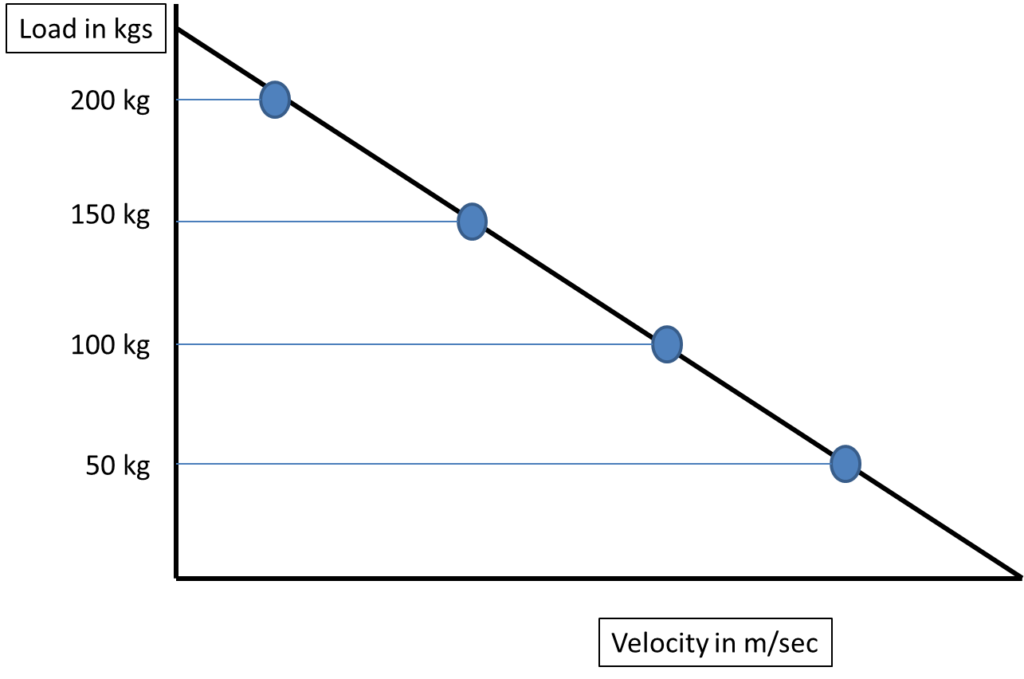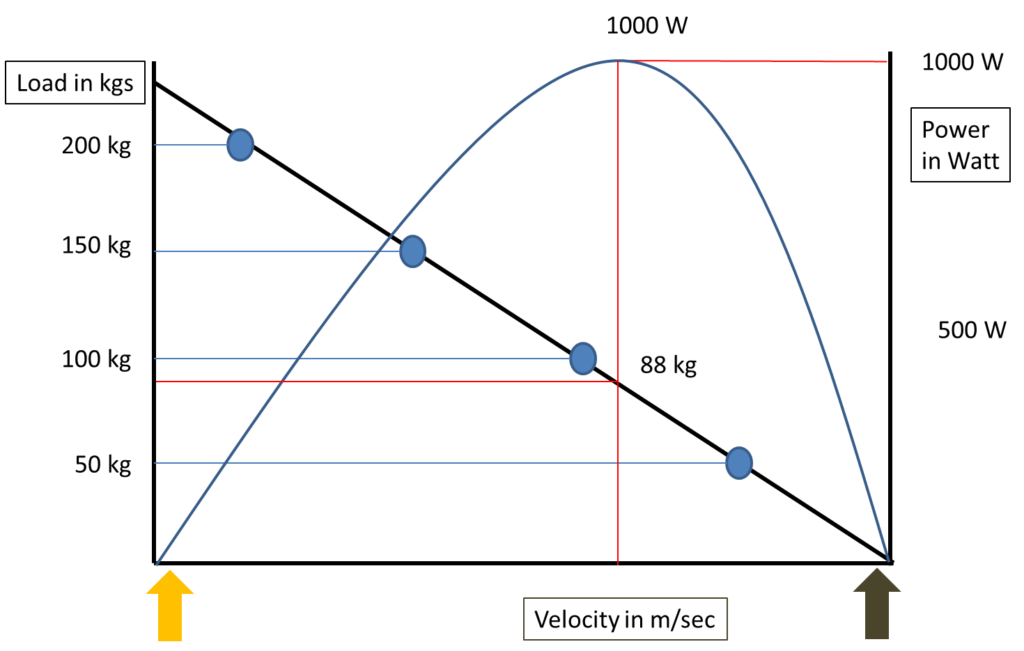It is a big thing right now in the US. Yes, one finally found out that the velocity of the execution plays an important role in movements too. Until recently the focus was on the force or load part of the movement. Great! We figured this out in the early 1990’s, almost twenty-five years ago. This tells you that despite the speed of the internet, the information flow for coaches is extremely slow, just like a hundred years ago. I no longer try to figure out why this is: completely irrelevant information crosses the planet within seconds, whereas an important development in your own field takes twenty-five years? It’s beyond comprehension!
Somewhere in the late 1980’s, one of my mentors, the late Carmelo Bosco, expanded on the idea of AV Hill (1), published in 1938, the force-velocity-curve. Bosco however, thought about more practical ways to measure the force-velocity curves of athletes to optimize their strength training. Some preliminary work had already been done by working with different loads and evaluating the changes in the F-V-curve (2).
Bosco wanted to transfer his ideas from the lab to the field, to real athletes, to improve performance in a simple and practical way. His cooperation with his colleague Dr.Jozsef Tihanyi from Hungary was fruitful and complemented his ideas (3,5).
One of the first articles about the principles of velocity-based training was published in a German journal.(4)
In other countries coaches also started to work with lower weights and look for power output (6). From 1990-1995 Bosco published many articles in English-language journals while working on having the right algorithms, the hardware and the software developed (7,8,9,10,14). This resulted in a first proper working machine (Biorobot) with which I worked and I wrote my first article about power training in 1995 (13).
In a later stage the value of the system was confirmed by another group of scientists (15). While in the meanwhile at the other side of the planet, also the Australians started to work with power (11,12).
The whole idea is quite simple: in sports we are always moving something, our own bodyweight, a barbell, a javelin, a racket, a ball or a bat, with a constant weight. In almost all cases the athlete tries to move that weight (or load) with the highest possible velocity. Paradoxically, the only exception to this is powerlifting in which the time or the velocity in which the powerlifter moves the barbell does not play a role as long as it gets into the final position.
The faster you throw, the further the ball will fly. The faster you extend your knees or legs in the vertical jump, the higher you will jump, the faster you raise the barbell in Olympic lifting, the more chance your attempt will be successful. Don’t believe it? Just try to jump or throw in slow motion and see what happens. The product of the load (body weight, barbell or ball) times the velocity with which you move it, is power output (expressed in Watt). Yes, there is a catch, the load changes as it accelerates or decelerates, see your body weight change while standing on a scale in a moving elevator.
The method is simple: first establish a force-velocity curve in a given exercise, let’s say squat.
Attach the equipment, whatever your method of measuring, to the barbell, so you can measure the velocity.
Put a load on a barbell e.g. 50 kg, make 5 reps each rep as fast as you can and take the best (fastest) of the five.
Now put a higher load on the barbell e.g. 100 kg, do the same (of course you will find the barbell to move slower due to the higher load).
Again increase the load to e.g.150 kg and if your 1 rep max is 220 kg, the last load will be e.g. 200 kg.
The software will show you a straight line which is force-velocity curve, nothing new here: the heavier the load, the slower you are able to move it.

But the software should also show you the force-power curve which is an inverted U-curve.
When the load is very high, the velocity is very low, almost zero, so the power output is low too (orange arrow). When the velocity is very high, the load has to be very low, so the power output is low as well (brown arrow).
But somewhere in the middle range of the load, between 30 and 60% of the 1 RM, the power output is at its highest e.g. 1000 Watt. So the load related to the peak power output (the top of the inverted U-curve- in this case 40% of 220 kgs) is the load to train for the highest power output (in this example 40% of 220 kg = 88 kg.). This load, 88 kg, is the load to train with and to be repeated as many times with the power output > 90% of the maximal power output (900 Watt or more).

After that you might train a lot, but just not increase power output. Maximum or high power output is mainly generated by the fast twitch or type II fibers which tend to fatigue fast and early, and sometimes, after 5-6 reps, they seem to drop out. We can check that by the power output (read velocity, since the weight is constant) drops more than 10%. So after 6 reps one exclusively trains slow twitch or type I fibers.
Another aspect of power training is that one does not need to get into the high load range >85% of the 1 RM, therefore in many cases reducing the risk of injury.
Velocity-based training, an old and well-tried principle promoted as being a breakthrough.
Bibliography.
1 Hill, A.V: The Heat of Shortening and the Dynamic Constants of Muscle, Proceedings of the Royal Society of London Series B, Vol. 126, issue 843, 1938, pg.136-195.
2 Kaneko, M; Fuchimoto, T; Suei, K: Training effect of different loads on the force-velocity relationship and mechanical power output in human muscle; Scand. J.Sports Sci, Vol.5, No.2, 1983, pg. 50-55.
3 Tihanyi, J; Apor, P; Fekete, G: Force-velocity-power characteristics and fiber composition in human knee extensor muscles; Eur.J.Appl.Physiol, Vol.48, 1982, pg. 331-343.
4 Bosco, C: Kontrolle des Krafttrainings durch das Kraft-Geschwindigkeits-Verhaltnis; Leistungssport, No.6, 1983, pg.23-28.(Monitoring of strength training by the force-velocity-relationship)
5 Tihanyi, J; Apor, P; Petrekanis, M: Force-velocity-power characteristics for extensors of lower extremities; in: Biomechanics X-B; Jonsson, B (Ed.) Human Kinetics, 1987, pg. 707-712.
6 Poprawski, B: Aspects of strength, power and speed in shot put training; New Studies in Athletics, No.1, 1988, pg. 89- 93.
7 Bosco, C: New Test for Training Control of Athletes; Keynote at Congress: “Techniques in Athletics”, Cologne, June 7-9-1990, pg.265-296.
8 Bosco, C: Eine neue Methodik zur Einschatzung und Programmierung des Trainings; Leistungssport No.5, 1992, pg. 21-28. (A new method for the estimation and programming of training)
9 Bosco, C: Evaluation and control of basic and specific muscle behavior, Part 1; Track Technique, Spring 1993, pg. 3930-3933, 3941.
10 Bosco, C: Evaluation and control of basic and specific muscle behavior, Part 2; Track Technique, Summer 1993, pg. 3947-3951, 3972.
11 Young, W.B: Training for speed/strength: heavy vs light loads; NSCA J. Vol.15, No.5, 1993, pg. 34-42.

Hi Henk,
Every time I see force velocity curve I am asking myself questions I can’t answer lol
So almost all sporting movements such as jumps and throws are at the far end velocity spectrum very fast but not much load. I am just lacking the bio-mechanical and physiological understanding why and how different training load which is further away from the right high velocity side such as squats with 50 kg actually affects the fast no load movement such as jump and throw. Is there anything you could suggest to read or do to fully understand how different intensity/velocity training affects the far end high velocity movements. Cheers!
Hello Kristoff. Thanks for your question. First explanation: two polarities in strength training 1.overload and 2. specificity. Both are inversely related!
At the high velocity end one might train more specific, but there is little overload (=training stimulus for strength and power). At the high force end one certainly has the overload but it much less specific e.g.lower velocity. With power training 30-60% of 1RM one still is within the range of both overload AND specificity. The second explanation has little to do with the curve in itself, but with Bosco’s measurements of EMG output and muscle-fiber recruitment at different loads and velocities. At the high velocity end, one is rather selectively recruiting FT fibers, but not all of them. At the high force end, one is recruiting all FT fibers, but also all ST fibers (low velocity). At the power range (30-60% of 1RM, executed at the highest possible velocity) one is rather selectively recruiting FT fibers only and most of them (more than at the high velocity end). I hope this explanation is helpful. Henk
Thanks, I appreciate your time and it definitely makes more sense to me now!
Thank you for answering this question as I had been grappling with it myself. Coaches, especially when it comes to the role of strength training in power sports, love to polarize their positions. Like you talked about in a previous blog post, one side says strength training for speed is worthless citing examples of scores of athletes who don’t use it, and are very successful. The opposite side heavily promotes strength training (especially heavy) as the holy grail of training for speed. But like you talk about, the actual answer requires a lot of nuance.
In terms of what Kristoff asked, I also have a question just as a clarification. For velocity-based training to increase speed, many coaches point out that even at the lightest weights (20% of 1RM for example) the bar (or whatever tool), at its max, moves 1-2 m/s. When running for maximum speed, the body moves at 12 m/s. In T & F throwing, the implements move anywhere from 13-40 m/s . So they say, you can’t duplicate that speed, so strength training is worthless. To get better, all you can do is practice the event.
But the answer is based less on the actual F-V curve. In our actual training for the competitive event we can’t recruit all our type 2 fibers. Based on what you’ve said here and my thoughts, am I correct in saying that we do the power training (30-60%) because of the selective recruitment of the Type 2 fibers that are used in our power sport actions? While also, because of the overload combined with some velocity, we recruit more (or all) of them while also providing a stimulus to them? We also are avoiding a high recruitment of the Type 1 fibers as well. Am I on the right track? Obviously, this is all in the context of a holistic training program based on the time of year/competition. Hopefully my question is clear. Thank you!